-
Recent Posts
Categories
Animals
Adelie Penguin Antarctic Fur Seal Arctic fox Arctic tern Baboon Bearded seal Black Browed Albatross Blue petrel Cape Petrel Chimpanzee Chinstrap Penguin Cod Crabeater Seal Elephant Seal Gentoo Penguin Giant Petrel Green Monkey Guillemot Harbour Seal hippopotamus Humpback Whale King Penguin Kittiwake Krill Leopard Seal Light Manteled Sootie Albatross Lizard Loggerhead turtle Minke Whale Musk ox Northern Fulmar Orca Polar bear Puffin Razorbill Red Colobus Reindeer Ringed Seal Rockhopper Penguin Shearwater Short-beaked common dolphin Skua Wandering Albatross Weddell Seal Wilsons Storm Petrel
Author Archives: admin
Layers of Lewis
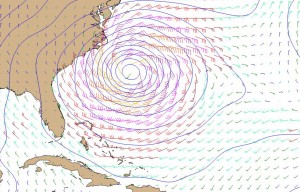 With over 5000 cold nautical miles under the keel at this point in the journey we are both elated to be on our way further south to warmer latitudes, and just a little weary of the increasingly wintery weather. On one hand, we are certainly glad that we diverted to the European coast as the entire North American coast is presently beset by incredibly strong winds emanating from Cyclone Sandy (see image). On the other hand, the situation here in the Outer Hebrides Islands could hardly be called settled (see image)! Indeed, an occasional flurry of snow hasbeen the only real break to the continued gloomy wet
With over 5000 cold nautical miles under the keel at this point in the journey we are both elated to be on our way further south to warmer latitudes, and just a little weary of the increasingly wintery weather. On one hand, we are certainly glad that we diverted to the European coast as the entire North American coast is presently beset by incredibly strong winds emanating from Cyclone Sandy (see image). On the other hand, the situation here in the Outer Hebrides Islands could hardly be called settled (see image)! Indeed, an occasional flurry of snow hasbeen the only real break to the continued gloomy wet 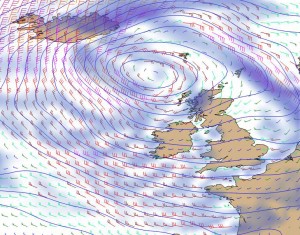 weather and strong winds we have experienced since arriving in the Isle of Lewis!
weather and strong winds we have experienced since arriving in the Isle of Lewis!
One advantage of being pinned down to wait out the weather systems is that we have had a chance to stretch our legs (though only when encased in our full Arctic wardrobe!). What has amazed me most about this landscape is the continuity of human occupation on this windswept island that was first settled around 8000 years ago. Walking over the rolling hills becomes difficult due to the constant need to scramble over the remains of some long abandoned dwelling. The reminders of the past are scattered over these rock strewn hills in a myriad of ruins and historical monuments – the crumbling remains of old stone houses stand side by side with modern occupied houses in the small villages; the crest of a hill overlooks an impressive rings of stones raised as tributes to gods long gone; the walls of an iron age fortification still stand guards against the bitter winds sweeping over the ocean … it seems there it a story buried under every rock in this place.
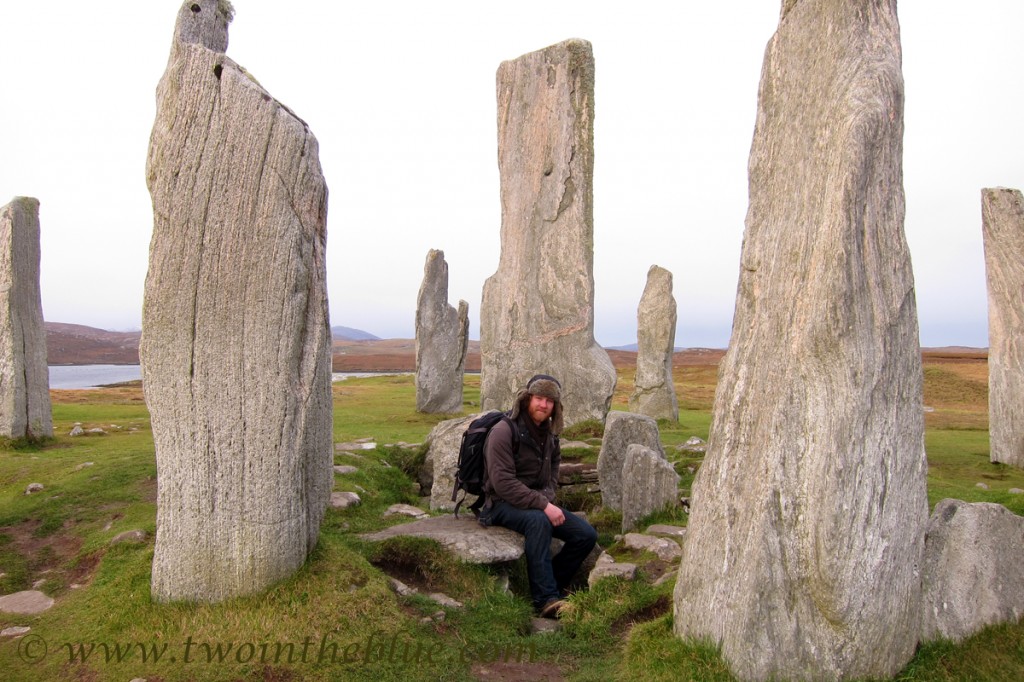 The history of the island also includes many influences from Viking raiders and settlers that intermarried with the Celtic inhabitants – yet for us we feel like we have finally stepped into a new dramatically different culture from the Scandinavian dominated countries of our route thus far. Don’t get me wrong, we have met some fantastic people in every country we have visited, and learning the habits of the diverse nations of the far north has been highly rewarding. Then again …. as an Australian I have to admit there is something extremely comforting about being able to but a cheap beer in a dingy pub and tuck into a meat pie with sauce for lunch …
The history of the island also includes many influences from Viking raiders and settlers that intermarried with the Celtic inhabitants – yet for us we feel like we have finally stepped into a new dramatically different culture from the Scandinavian dominated countries of our route thus far. Don’t get me wrong, we have met some fantastic people in every country we have visited, and learning the habits of the diverse nations of the far north has been highly rewarding. Then again …. as an Australian I have to admit there is something extremely comforting about being able to but a cheap beer in a dingy pub and tuck into a meat pie with sauce for lunch …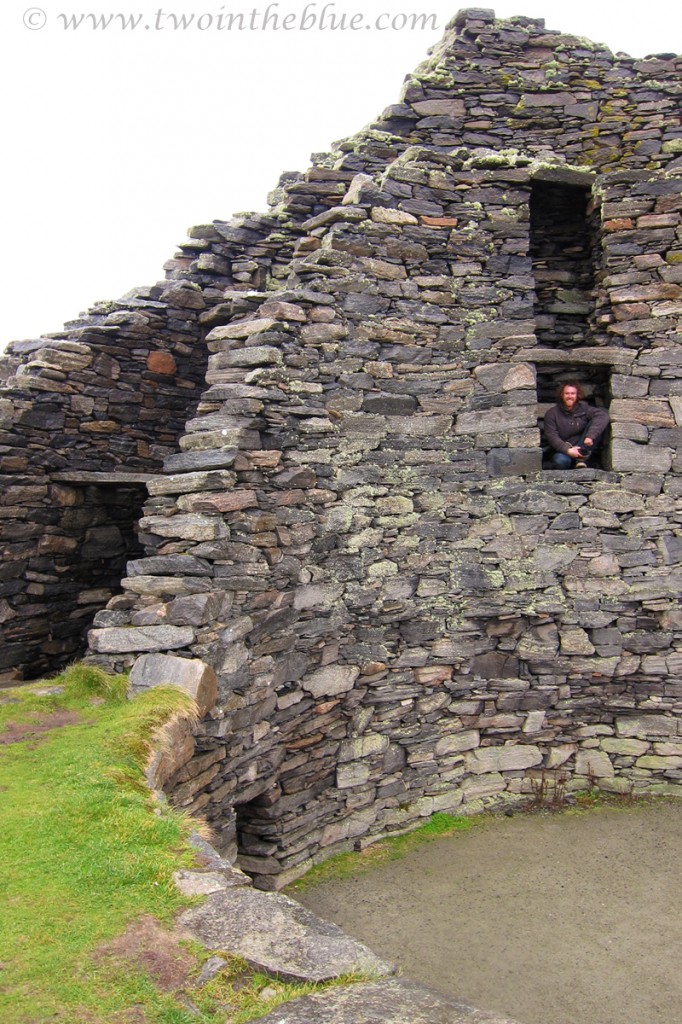
Our own Iceland sagas: mechanics, not monsters
 The history of Iceland is well known thanks to the Icelandic sagas that document the various battles and hardships undergone by the first Viking settlers of far-flung Thule. As we sailed towards Vopnafjordur on the East Coast of Icland we were reflecting a little upon the saga of the power struggle of the region between the clans of Hof and Krossavik, and also of the tales in the saga “Heimskringla”. According to legend, the first a sailor to arrived in the harbour found an enormous
The history of Iceland is well known thanks to the Icelandic sagas that document the various battles and hardships undergone by the first Viking settlers of far-flung Thule. As we sailed towards Vopnafjordur on the East Coast of Icland we were reflecting a little upon the saga of the power struggle of the region between the clans of Hof and Krossavik, and also of the tales in the saga “Heimskringla”. According to legend, the first a sailor to arrived in the harbour found an enormous  dragon guarding the bay and driving the sailors away with fire and his host of lizards and insects (the lizards must have been later eaten by the dragon since none exist here today). This tremendous beast has long been thought to be the guardian of northeast Iceland, and as wary seafarers we were looking to the skies for trouble in the form of fire-breathing leviathans. Alas, however, trouble again came from our increasingly temperamental engine rather than from any disgruntled dragons.
dragon guarding the bay and driving the sailors away with fire and his host of lizards and insects (the lizards must have been later eaten by the dragon since none exist here today). This tremendous beast has long been thought to be the guardian of northeast Iceland, and as wary seafarers we were looking to the skies for trouble in the form of fire-breathing leviathans. Alas, however, trouble again came from our increasingly temperamental engine rather than from any disgruntled dragons.
A few days ago the fantastic mechanics at Siglufjörđur finally managed to fix our previous engine woes. However, the rainy, windy and cold weather kept us for another couple of days in town, until finally a nicer weather window allowed us to pull in our lines and head east. And it felt great to be mobile again! The conditions were beautiful, the wind for once came from the right angle too (not from the bow as usual), and since we are really very far behind schedule, we decided to keep going through the night to cover as much ground as possible while the nice weather lasted.
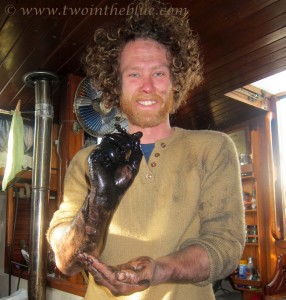 After over 30 hours of straight sailing we finally approached Vopnafjörđur, which is the only sheltered harbour between the bleak headland of Langanes and the fjords of the southeast. However, similar to our first approach to Siglufjörđur, just as we were in sight of the town, our motor started to play up once again. This time, the engine simply would not go faster than idle anymore. It was not really a problem to get into the harbour and we arrived with just the occasional “clunk” to betray our sad state. Yet now our mechanical sorrows are again the first priority. Right now, Patrick is trying to figure out what might cause this particular problem, and if he can fix it himself, though his oil smeared face suggests just a little hint of desperation. Since one of our next stops is the Faroe Islands, where roaring tidal currents of up to 12 knots surge through narrow fjords, we better make sure our engine works properly before hitting the road again … fingers crossed that it won’t take too long!
After over 30 hours of straight sailing we finally approached Vopnafjörđur, which is the only sheltered harbour between the bleak headland of Langanes and the fjords of the southeast. However, similar to our first approach to Siglufjörđur, just as we were in sight of the town, our motor started to play up once again. This time, the engine simply would not go faster than idle anymore. It was not really a problem to get into the harbour and we arrived with just the occasional “clunk” to betray our sad state. Yet now our mechanical sorrows are again the first priority. Right now, Patrick is trying to figure out what might cause this particular problem, and if he can fix it himself, though his oil smeared face suggests just a little hint of desperation. Since one of our next stops is the Faroe Islands, where roaring tidal currents of up to 12 knots surge through narrow fjords, we better make sure our engine works properly before hitting the road again … fingers crossed that it won’t take too long!
Pieces of Perkins
Those of you who have been following our adventure might have noticed several points in the trip where we have been landlocked due to problems with our “Perkins” diesel engine. Alas, whilst age lends a certain character to a sailing ship, the passing years also tend to make them temperamental. With our particular old girl the body is holding up strongly but the engine is definitely starting to show signs of wear and tear.
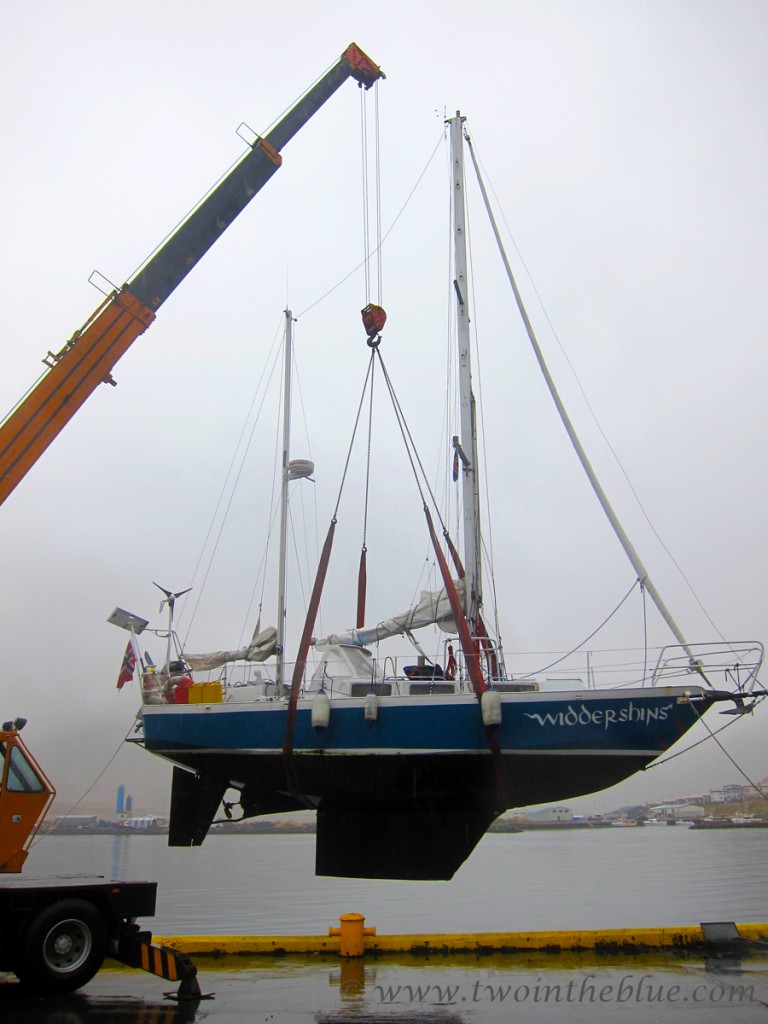 Since starting on this trip we have replaced: the starter motor (worn parts on the bit that makes the engine start), the brackets (the bits that hold the engine onto the boat broke), the air intake manifold (the bit where the air comes in fell off), the flexible coupling (the bit that spins around and stops the propeller from wobbling too much), and the injector pump (the bit that pumps fuel into the parts where it is burnt to magically move the boat from point A to point B).
Since starting on this trip we have replaced: the starter motor (worn parts on the bit that makes the engine start), the brackets (the bits that hold the engine onto the boat broke), the air intake manifold (the bit where the air comes in fell off), the flexible coupling (the bit that spins around and stops the propeller from wobbling too much), and the injector pump (the bit that pumps fuel into the parts where it is burnt to magically move the boat from point A to point B).
Following a short journey through Eyjafjörður where the engines performance produced a rather unsettling series of groans, coughs and taps we are, once again, back on dry land performing open heart surgery to try and rejuvenate the poor old engine. This time, the friendly, competent and extremely helpful mechanics at JE Vélanverkistæði (who are also building brand new fibreglass boats, www.sigloseigur.com) have taken the boat out of the water to realign the engine and the propeller shaft. Moreover, they have delicately removed the injectors (the bits that spray fuel into the parts where it is burnt) to discover that (somewhat like the rest of the boat at the moment) they are rather dirty and not moving at all as they should. The result: another few days in harbour while new parts are delivered and the engine can be put back together.
All this is rather dispiriting in a way, though the town of Siglufjorður is a magic place to spend a week or so. However, we do try and see the bright side of things … at the rate we are presently replacing parts we should arrive in Antarctica with virtually a new engine … hmmm.
Posted in Uncategorized
1 Comment
The herring prince and the sleeping beauty
After one week in Siglufjördur, we finally have a functioning engine again, and are ready to move on. However, being involuntarily stranded here for a few more days than planned allowed us to explore the surroundings and the town itself more and has given us a fantastic opportunity to touch base with locals.
Despite its appearance as a sleepy coastal village, Siglufjördur actually played an important role in Iceland’s recent history. Iceland was one of the most impoverished countries of Europe at the turn of the last century, until the discovery of huge herring shoals at the north coast of Iceland provided the impetus to a new era of prosperity. As the folk of Siglufjördur say “herring was the prince that awoke the sleeping princess with a fishy kiss”… and if the prince had a home it would surely be this scenic little town. Nowhere else was the fishing fleet larger, or the number of processed herring higher. Each season hundreds of thousands of barrels of herring were salted or processed into oil and meal, contributing as much as 44% to Iceland’s income. The town, of course, grew rapidly and flourished providing an abundance of job opportunities for fishermen, herring girls, coopers, mechanics and many more. Indeed the streets of Siglufjördur were bustling to the extent that the crowded main street was compared to the bustling streets of London!
 The prince however was becoming restless. In the 1950s the herring started to become less and less – but the smell of herring that hung thickly over the town was likened to the smell of money and the Icelanders were not yet ready to let the prince escape. As the herring shoals became increasingly hard to find new technologies such as the use of echo-sounders to locate the herring school managed to keep the herring coming. As new shoals became available the herring boomed again in the early 60s and Siglufjördur continued to prosper.
The prince however was becoming restless. In the 1950s the herring started to become less and less – but the smell of herring that hung thickly over the town was likened to the smell of money and the Icelanders were not yet ready to let the prince escape. As the herring shoals became increasingly hard to find new technologies such as the use of echo-sounders to locate the herring school managed to keep the herring coming. As new shoals became available the herring boomed again in the early 60s and Siglufjördur continued to prosper.
But suddenly, it was all over. In 1968, almost no herring was caught, and the bustling factories stood empty leaving the people of the town without jobs. The prince, it seems, had slipped away and Iceland fell into a huge depression that surpassed the great depression in terms of the adversity felt by Iceland people. Fishermen and their families moved away from Siglufjördur, leaving the town to decay. The factories and wharves that once bustled slowly subsided into the sea leaving the town with a downcast air.
But the folk of Siglufjördur are nothing if not resilient. After a period of decline lasting until the 1990’s, local residents banded together with the aim of restoring the former glory of the town. At this point a smaller pool of fishermen called the town home and fishing was still important – following strict quotas enforced by the Icelandic government the herring had returned, though in lesser numbers, and now other fisheries including cod, shrimp and capelin all contributed to the catch of the town. While fishing was never to be as profitable and the great “Herring Adventure” proved, the town had retained its fishing heritage. And heritage had become a lynchpin of the community here. Örlygur Kristfinnsson, the director of the local museum (www.sild.is) was one of the citizens who helped kick-start the rejuvenation of the town by founding a museum focusing on the history of the Herring Adventure. The museum, which is now a central attraction in the town, has won various Icelandic and European awards and paints a vivid picture of the life of the town during the boom. But more importantly perhaps, the development reflects a shift in the lifestyle of the folk here in Siglufjördur. While fishing will always be fundamentally important to the town new opportunities such as tourism are beginning to play an important role. The magic of the town however, is the fact that the history and cultural heritage is not enclosed by the walls of the museum – the history of the herring seems an integral part of the town itself and the people living here.
Posted in Uncategorized
Leave a comment
Steaming water: bubbling through volcanic vents and vanquished valves.
After the past months of nearly non-stop sailing we have had the unexpected pleasure of nearly a week in Siglufjördur on the North coast of Iceland. Unexpected I say, since once again we have been brought to a halt by problems of a mechanical nature.
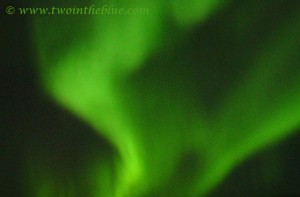 Shortly after the last blog we unfurled the sails and spend a glorious day and a nights sailing around the rugged coastline of the North West. Sheer cliffs flank the coast in this part of Iceland and the first sunshine we had seen for some time illuminated the ochre coloured rocks before they gave way to a gentle dusting of white snow. Meanwhile the sky above was vivid blue and the sea presented a myriad of shades from deep green through to aquamarine. Days like this are a sailors dream and as luck would have it, a perfect day gently slipped into a perfect night. The sun painted the horizon with reds as it dipped below calm sea and soon a startling array of stars appeared in the heavens to guide us through the dark water. As if in answer to the lights above, phosphorescent algae trailed in our wake adding flashes of green to the cold white light of the stars. And still the light show was not over – as we leaned back and trained our eyes on the constellations faint bands of green began to play across the northern horizon. Soon we were sailing under the shimmering cascades of light belonging to the Aurora Borealis.
Shortly after the last blog we unfurled the sails and spend a glorious day and a nights sailing around the rugged coastline of the North West. Sheer cliffs flank the coast in this part of Iceland and the first sunshine we had seen for some time illuminated the ochre coloured rocks before they gave way to a gentle dusting of white snow. Meanwhile the sky above was vivid blue and the sea presented a myriad of shades from deep green through to aquamarine. Days like this are a sailors dream and as luck would have it, a perfect day gently slipped into a perfect night. The sun painted the horizon with reds as it dipped below calm sea and soon a startling array of stars appeared in the heavens to guide us through the dark water. As if in answer to the lights above, phosphorescent algae trailed in our wake adding flashes of green to the cold white light of the stars. And still the light show was not over – as we leaned back and trained our eyes on the constellations faint bands of green began to play across the northern horizon. Soon we were sailing under the shimmering cascades of light belonging to the Aurora Borealis.
Sound perfect? Well we thought so until our intended destination appeared ahead of us at dawn and the wind died down …. time to switch on the motor and make our way into the harbour. Alas the first few coughs of the engine ended in a splutter and a bang and henceforth the whirring of the starter motor failed to illicit any sign of life. Thus after making an average of 6 – 7 knots over the past 24 hours we entered the harbour under sail making a mere half a knot in the flagging wind and watched the docks draw near at a maddeningly slow pace. Coming into a harbour under sail is always a little tricky but eventually we gently touched the jetty of Siglufjordur and went in search of repairs.
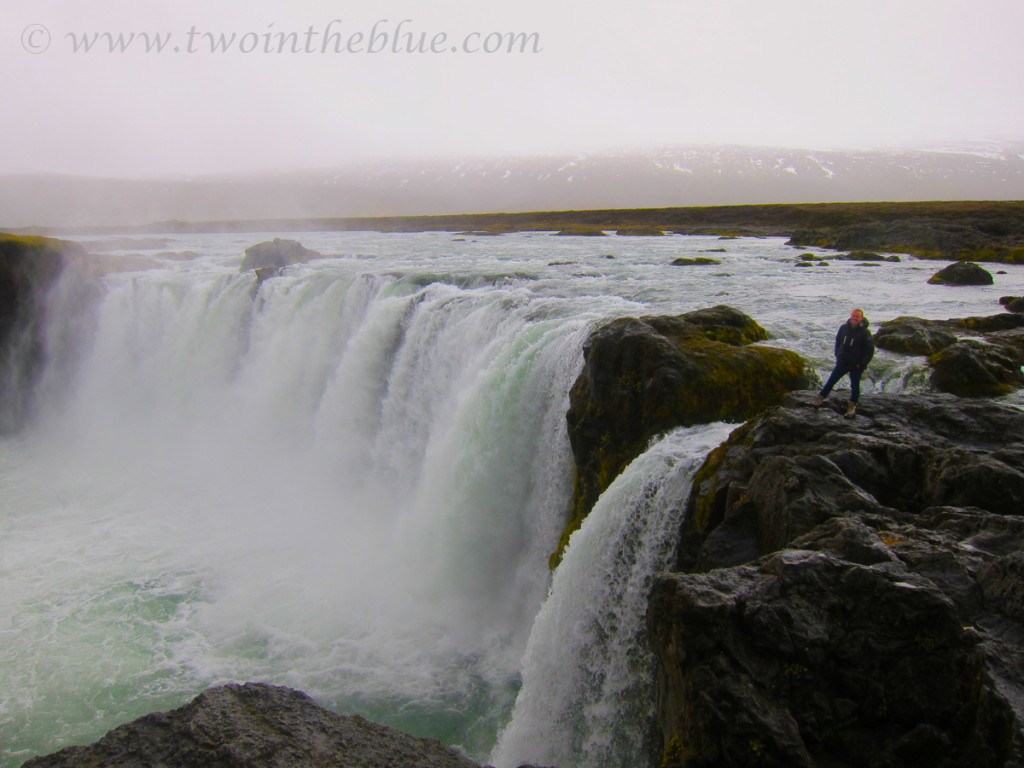 We won’t bore you with the trials and tribulations of repairing and engine (these include nearly sinking the boat when the wrong sea-cock was turned and the boat was left to slowly fill with seawater overnight) – suffice to say that valves on a pump were blocked with water and we are now awaiting the return of the offending part.
We won’t bore you with the trials and tribulations of repairing and engine (these include nearly sinking the boat when the wrong sea-cock was turned and the boat was left to slowly fill with seawater overnight) – suffice to say that valves on a pump were blocked with water and we are now awaiting the return of the offending part.
 On the positive side, we have had a few glorious (though rather wet thanks to the persistent rain) days in the North of Iceland. We have toured through the volcanic terrain of Myvaten to see bubbling cauldrons of mud, steaming fumaroles and tranquil blue lakes disturbed by jets of boiling water erupting from the earth. The locals here have made us feel incredibly welcome and have offered hospitality and sympathetic advice along with a few of the creature comforts we have been missing of late – good coffee, a book and a long soak in a geothermally heated pool go a long way to alleviate the stress of being stranded.
On the positive side, we have had a few glorious (though rather wet thanks to the persistent rain) days in the North of Iceland. We have toured through the volcanic terrain of Myvaten to see bubbling cauldrons of mud, steaming fumaroles and tranquil blue lakes disturbed by jets of boiling water erupting from the earth. The locals here have made us feel incredibly welcome and have offered hospitality and sympathetic advice along with a few of the creature comforts we have been missing of late – good coffee, a book and a long soak in a geothermally heated pool go a long way to alleviate the stress of being stranded.
Posted in Iceland
Leave a comment
Anyway the wind blows …
As we sit in a café in Iceland and watch the cold breeze blow drifts of sleet across the empty street we have to consider the onward journey. According to our existing plan we are faced with a three week voyage across the north Atlantic to the rugged shores of Newfoundland. As we consider the prospect of a long cold slog into the autumn gales we have an even more alarming vision than the squalls of occasional snow outside – on the computer before us is a live weather forecast displaying a continuous series of low pressure systems marching across our intended route attended by a rather colourful array of barbed arrows indicating gale force winds and wicked weather.
 Intrepid adventurers we may be, yet the prospect of weeks at sea being cast about like froth on the raging ocean is enough for us to consider alternatives. The past two months of Arctic adventure has seen us face all arrays of weather but winter is definitely nipping at our heels and even once we brave the long hard slog across the Atlantic we are faced with an even longer race down the east coast of America as we try and keep ahead of the coldest and most miserable weather marking the vanguard of the approaching winter.
Intrepid adventurers we may be, yet the prospect of weeks at sea being cast about like froth on the raging ocean is enough for us to consider alternatives. The past two months of Arctic adventure has seen us face all arrays of weather but winter is definitely nipping at our heels and even once we brave the long hard slog across the Atlantic we are faced with an even longer race down the east coast of America as we try and keep ahead of the coldest and most miserable weather marking the vanguard of the approaching winter.
The alternative? A short two day sail from the east coast of Iceland with the wind at our backs would take us to the craggy coast of the Faroe Islands. Taking this route we could visit the north coast of Scotland, subsequently sail towards the green hills of Ireland, the Cornish coast of England and then across the Bay of Biscay to Portugal. From here we can take the well-trodden path to the Caribbean first advocated by Columbus when he sailed into the unknown. While still racing against the winter, the major advantages of this change in route would be that the winds would be with us, the sea-legs would be shorter, and importantly for us, it would give us a little more time to explore the destinations on our way.
The final decision is still before us as we are presently locked into a nice sheltered harbour as a depression blows out its forty knot fury off the coast. However, tomorrow we will either turn south to make for Reykjavik with the intention of talking the long hard slog west; or we will turn to the east and make for the more sheltered solution. Both routes offer advantages and disadvantages and we are still torn … some serious consideration over a warm mug of mulled wine is in order I think!
Posted in Iceland
5 Comments
Iceland: greener than Greenland and no ice


The passage from Greenland to Iceland was a fast one since we had a thirty knot tail wind for most of the way on account of the storm system that was hot on our tail. Luckily we managed to duck into the sheltered harbour of Isafjordur on the northwest before the worst of it hit. The passage was a little grim due to the steel grey skies and as usual we were weary when we finally sighted land. However the welcome sight of cliffs on the horizon was accompanied by a pod of over one hundred white-beaked dolphins that gave us a fantastic escort into the harbour. Our welcoming squad proceeded to leap and flip on all sides of the boat and to ride beneath the prow of the yacht with one eye on Leonie as the laughed and waved at these friendly beasts.
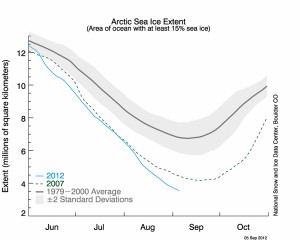 On a serious note, we were again astonished by the lack of sea ice over the entire arctic leg of the voyage. We did have to duck and weave between some icebergs as we left Greenland behind us, but this time we encountered no sea ice at all on a leg that is notorious for being choked with ice. It is easy to form erroneous opinions when you just get a snap shot of the long term picture … you can hardly call a state of emergency just because one yacht sails through an eerily ice-free arctic ocean. But then again if you collate the long term satellite records it is clear that the arctic truly is in a rapid state of change. The National Snow and Ice Data Centre shows that this year is the lowest ice year on record and we are still not even at the annual ice minimum. Scary times indeed and while the effect here is undeniable, this change is something that will affect the entire world. Time to start thinking of the future of the planet each time we fill up Widdershins with diesel!
On a serious note, we were again astonished by the lack of sea ice over the entire arctic leg of the voyage. We did have to duck and weave between some icebergs as we left Greenland behind us, but this time we encountered no sea ice at all on a leg that is notorious for being choked with ice. It is easy to form erroneous opinions when you just get a snap shot of the long term picture … you can hardly call a state of emergency just because one yacht sails through an eerily ice-free arctic ocean. But then again if you collate the long term satellite records it is clear that the arctic truly is in a rapid state of change. The National Snow and Ice Data Centre shows that this year is the lowest ice year on record and we are still not even at the annual ice minimum. Scary times indeed and while the effect here is undeniable, this change is something that will affect the entire world. Time to start thinking of the future of the planet each time we fill up Widdershins with diesel!
For now however, we are exploring a new land – here are rugged cliffs and high hills dusted by snow from the recent storm system. There is also green field in the low lands and even the first trees we have seen since leaving Norway! Such a nice change to sit under a tree (albeit a rather stunted specimen) watching people stroll down the street and not have to carry a rifle around as protection from bears!
Dawn Chorus
This morning we awoke to a strange new sound … and when you are living on a yacht in the arctic new sounds take on a new significance. The thing is, life aboard a yacht is never quite quiet. You become attuned to all the range of creaks, groans, tappings, whistles and gurgles that are the boat talking to you – and they are all sending you a message. The wind is increasing, the waves are building, there is a loose rope that needs to be tightened … you end up learning to know the language of the ship and what she wants you to do when she wakes you from your sleep with a whisper in your ear (or a scream as sometimes happens). This morning however, we awoke to a bizarre gurgling, scraping, grinding sound that was enough to raise the hairs on the back of the neck.
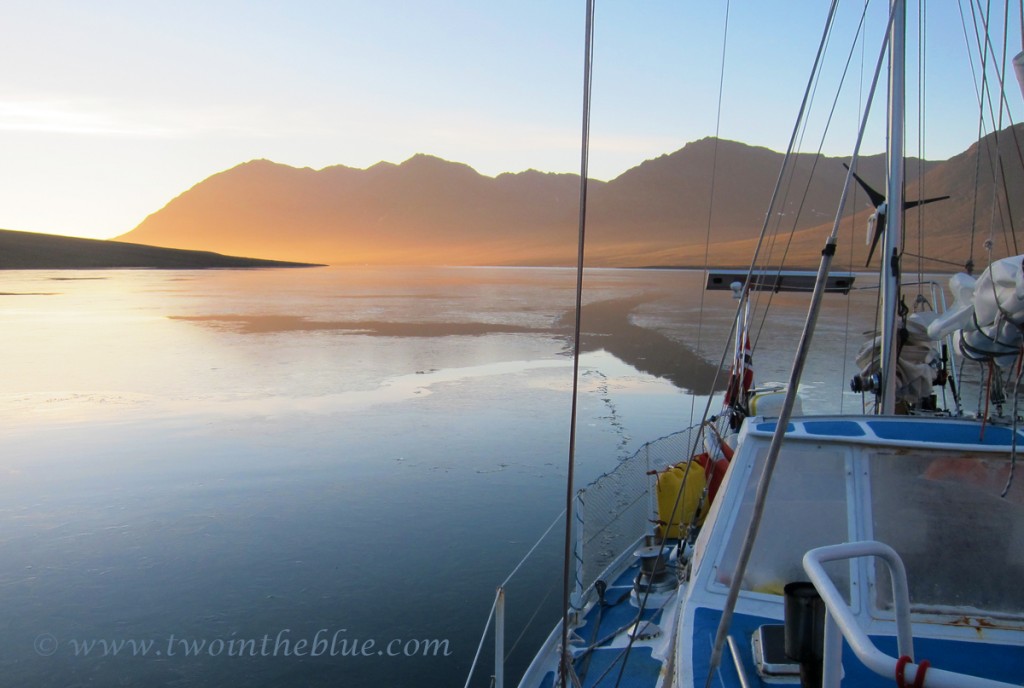 Needless to say such a strange sound caused a surge of adrenalin through the system and before you could say “hungry polar bear” I was up on deck in my long johns trying to decipher this cryptic new message from our yacht “Widdershins”. The vision that greeted my eyes was a new one for me: the entire bay that we had anchored in overnight had been transformed from a calm oasis with gently lapping waves into a solid sheet of ice that had formed overnight. The view was completed by the heads of a couple of ringed seals popping out from the occasional lead to peer at the strange apparition that was gurgling and grinding away to break the tranquillity of a perfect arctic dawn.
Needless to say such a strange sound caused a surge of adrenalin through the system and before you could say “hungry polar bear” I was up on deck in my long johns trying to decipher this cryptic new message from our yacht “Widdershins”. The vision that greeted my eyes was a new one for me: the entire bay that we had anchored in overnight had been transformed from a calm oasis with gently lapping waves into a solid sheet of ice that had formed overnight. The view was completed by the heads of a couple of ringed seals popping out from the occasional lead to peer at the strange apparition that was gurgling and grinding away to break the tranquillity of a perfect arctic dawn.
 The gurgling, scraping noise, as it turns out, was caused by the ice drifting past the hull as it was carried out of the bay with the outgoing tide. The wind was dead calm and thus grinding of the ice caressing our hull as it sought escape was the only sound apart from the occasional snort of the bemused seals looking on with sceptical eyes. The grinding ice was doing no damage to the hull of course as it was only about 1 cm thick, yet I was a little worried about the sharp edges sawing through the rope anchor line that was holding us stationary in relation to the ice. A bit of quick thinking and I had a boat hook wrapped around the rope to take the brunt of the abrasion and we could relax. I was free to take in this novel experience with a hot cup of coffee.
The gurgling, scraping noise, as it turns out, was caused by the ice drifting past the hull as it was carried out of the bay with the outgoing tide. The wind was dead calm and thus grinding of the ice caressing our hull as it sought escape was the only sound apart from the occasional snort of the bemused seals looking on with sceptical eyes. The grinding ice was doing no damage to the hull of course as it was only about 1 cm thick, yet I was a little worried about the sharp edges sawing through the rope anchor line that was holding us stationary in relation to the ice. A bit of quick thinking and I had a boat hook wrapped around the rope to take the brunt of the abrasion and we could relax. I was free to take in this novel experience with a hot cup of coffee.
As I sat on deck with my hands wrapped around the mug it was again time to reflect that the season was coming to a close. The winter is fast approaching and before long this bay will be permanently encapsulated in sea ice. Definitely time to head south along with the continuous flights of barnacle geese winging overhead. We just have to wait out the next storm system passing through tomorrow and we will raise the anchor and head on.
Missing the musk ox
 First up, apologies for the scarcity of blogs of late but it turns out the satellite reception here on the remote east coast of Greenland is somewhat occluded by the towering peaks and icecaps that surround us. Nether-the-less we have been busy exploring the region …. In the water, along the coast and inland!
First up, apologies for the scarcity of blogs of late but it turns out the satellite reception here on the remote east coast of Greenland is somewhat occluded by the towering peaks and icecaps that surround us. Nether-the-less we have been busy exploring the region …. In the water, along the coast and inland!
 Once settled into the picturesque anchorage of Ittoqqortoormiit we quickly donned the dry suits and plunged into the water which our dive computers quickly pointed out was somewhere in the range of 0-3°C! Despite the slight ice-cream headache experienced upon slipping into the clear waters the life here is far more varied and colourful than we have seen elsewhere in the Arctic. Here we started seeing larger fish in amidst the waving fronds of kelp and an array of shrimps, brittle stars, nudibranchs, ascidians and other life to provide distraction from the cold. There is also an interesting array of bottles, bullet clips, china and other refuse lining the underwater landscape to stand as testimony to the almost 100 years of human occupation in this remote outpost.
Once settled into the picturesque anchorage of Ittoqqortoormiit we quickly donned the dry suits and plunged into the water which our dive computers quickly pointed out was somewhere in the range of 0-3°C! Despite the slight ice-cream headache experienced upon slipping into the clear waters the life here is far more varied and colourful than we have seen elsewhere in the Arctic. Here we started seeing larger fish in amidst the waving fronds of kelp and an array of shrimps, brittle stars, nudibranchs, ascidians and other life to provide distraction from the cold. There is also an interesting array of bottles, bullet clips, china and other refuse lining the underwater landscape to stand as testimony to the almost 100 years of human occupation in this remote outpost.
 Once dried out we headed further into Scoresbysund, the largest fjord system in the world, and ultimately anchored in the deep ford named Hurry Inlet by Scoresby. The aim here was to find the elusive musk oxen that roam these hills. After twenty kilometres of stumbling over varied terrain that included sandy desert, arctic tundra, rocky scree, swampy moorland and jagged boulder fields we had found plenty of signs of the beasts, such as prints, errant tufts of hair, droppings and the odd skull left by a more successful tracker than us … but still no ox! Regardless of this failure we had perhaps one of the most pleasant walks of the trip thus far.
Once dried out we headed further into Scoresbysund, the largest fjord system in the world, and ultimately anchored in the deep ford named Hurry Inlet by Scoresby. The aim here was to find the elusive musk oxen that roam these hills. After twenty kilometres of stumbling over varied terrain that included sandy desert, arctic tundra, rocky scree, swampy moorland and jagged boulder fields we had found plenty of signs of the beasts, such as prints, errant tufts of hair, droppings and the odd skull left by a more successful tracker than us … but still no ox! Regardless of this failure we had perhaps one of the most pleasant walks of the trip thus far.
 Our stroll included some fantastic wildlife sightings such as a pair of bright white arctic hares bounding over the rock fields, small pippits playfully dogging our footsteps and the Greenlandic white morph of the gyrfalcon circling overhead. After Leonie expressed her doubts about any polar bears possibly heading this far into the fjord we also stumbled over a long line of fresh polar bear prints ambling along the shoreline! The vegetation also caught our eye. Colourful flowers still nodded on the slopes of the hill; however the fields of dwarf birch and other vegetation displayed hues of red and orange to flag the rapidly approaching end of summer. Clearly the season here is drawing to a close and it is time for us to head south in the wake of the many flights of geese winging overhead … next stop Iceland!
Our stroll included some fantastic wildlife sightings such as a pair of bright white arctic hares bounding over the rock fields, small pippits playfully dogging our footsteps and the Greenlandic white morph of the gyrfalcon circling overhead. After Leonie expressed her doubts about any polar bears possibly heading this far into the fjord we also stumbled over a long line of fresh polar bear prints ambling along the shoreline! The vegetation also caught our eye. Colourful flowers still nodded on the slopes of the hill; however the fields of dwarf birch and other vegetation displayed hues of red and orange to flag the rapidly approaching end of summer. Clearly the season here is drawing to a close and it is time for us to head south in the wake of the many flights of geese winging overhead … next stop Iceland!
Posted in Greenland
Tagged Arctic hare, Ascidian, Brittle star, Gyrfalcon, Musk ox, Nudibranch, Pippit, Polar bear, Shrimp
Leave a comment
Of Ice and Ittoqqortoormiit
 Last night the fog that had been shrouding our passage across the Greenland Sea lifted to display a bright sun in a glorious blue sky. The horizon was punctuated by the first icebergs of the passage lined up like the teeth of the world. As the sun lowered towards the west we found ourselves skirting towers of ice reaching with craggy fingers towards the heavens. However, the new experience of night at these latitudes promised a scary new adventure – sailing through ice in the dark! As it turned out we had pretty clear seas for most of the night with only the occasional berg glowing white in the gloom. It wasn’t until the darkest hour of the night that we finally found our nerves a little frayed as we suddenly hit bands of dense fog…and those scattered dots on the radar … waves or ice? Oh …. ice ….. lots of it!
Last night the fog that had been shrouding our passage across the Greenland Sea lifted to display a bright sun in a glorious blue sky. The horizon was punctuated by the first icebergs of the passage lined up like the teeth of the world. As the sun lowered towards the west we found ourselves skirting towers of ice reaching with craggy fingers towards the heavens. However, the new experience of night at these latitudes promised a scary new adventure – sailing through ice in the dark! As it turned out we had pretty clear seas for most of the night with only the occasional berg glowing white in the gloom. It wasn’t until the darkest hour of the night that we finally found our nerves a little frayed as we suddenly hit bands of dense fog…and those scattered dots on the radar … waves or ice? Oh …. ice ….. lots of it!
 I have to admit my nerve failed me …. Rather than steering blindly through an unknown field of ice I dropped the sails, did an about turn to steer around the nearest few bergs and then settled down to drift amongst the ice until the light returned. It turned out to be a good choice. The scattered bergs we stumbled across were actually the outliers of quite a substantial band of sea ice that it took quite a few hours of twisting and turning to get though. The ice here is very different to Antarctica where generally you encounter single year sea-ice that is low and flat in profile. Here the sea ice is ridged and hummocked from the immense pressures of the drifting ice pack of the pole. Occasionally towering chunks of multi-year ice stand like monsters amidst the other flows and our poor little Widdershins looked like a toy boat amidst the splendid and scary sight of the Arctic pack ice.
I have to admit my nerve failed me …. Rather than steering blindly through an unknown field of ice I dropped the sails, did an about turn to steer around the nearest few bergs and then settled down to drift amongst the ice until the light returned. It turned out to be a good choice. The scattered bergs we stumbled across were actually the outliers of quite a substantial band of sea ice that it took quite a few hours of twisting and turning to get though. The ice here is very different to Antarctica where generally you encounter single year sea-ice that is low and flat in profile. Here the sea ice is ridged and hummocked from the immense pressures of the drifting ice pack of the pole. Occasionally towering chunks of multi-year ice stand like monsters amidst the other flows and our poor little Widdershins looked like a toy boat amidst the splendid and scary sight of the Arctic pack ice.
 Luckily dodging ice was only a limited diversion and soon clear waters opened up with only the occasional majestic berg bobbing on a horizon that was now clear and crisp. Passing the band of ice seemed to be like crossing a barrier into the true arctic – suddenly the temperature plummeted below zero, there was ice on the rigging and when the sails clapped in a gust of wind they sendt plates of ice crashing to the deck. We had also passed into whale territory – soon after the sea-ice slipped behind in our wake we were seeing the occasional blow of a whale on the horizon and soon we had the tails of humpback whales gracefully tipping up beside the boat as the beasts slipped into the depths. We encountered several; groups of humpbacks, some of which circled the boat very closely to cast a curious eye at us, as we in turn ran euphorically backwards and forward watching these beautiful animals.
Luckily dodging ice was only a limited diversion and soon clear waters opened up with only the occasional majestic berg bobbing on a horizon that was now clear and crisp. Passing the band of ice seemed to be like crossing a barrier into the true arctic – suddenly the temperature plummeted below zero, there was ice on the rigging and when the sails clapped in a gust of wind they sendt plates of ice crashing to the deck. We had also passed into whale territory – soon after the sea-ice slipped behind in our wake we were seeing the occasional blow of a whale on the horizon and soon we had the tails of humpback whales gracefully tipping up beside the boat as the beasts slipped into the depths. We encountered several; groups of humpbacks, some of which circled the boat very closely to cast a curious eye at us, as we in turn ran euphorically backwards and forward watching these beautiful animals.
Regardless of the spectacular end to the passage these weary sailors were looking forward to a rest, and the sight of the settlement of Ittoqqortoormiit (more pronounceabely known as Scoresbysund) was a welcome relief. Against the forbidding backdrop of bare rock and a distant ice cap, this small settlement is a small island of humanity in a rugged, icy land. However, it is also a community like nothing else we have encountered. Here subsistence hunting is the general rule – with only 2 supply ships bringing fresh provisions each year the local people rely very much upon harvesting seal, muskox, ducks and polar bear to provide the nutrition they need. Hanging up beside the drying clothes in front of the houses it is a common sight to see the shaggy pelt of an musk ox, or the white hide of a bear sending its rank odour into the breeze.
 After a short period of awkward glances and shy hellos the people here have provided a warm welcome to us – in fact we can barely walk down the street without being accosted by children attacking us with imaginary guns or other inventive games of “tourist baiting”. It is another world here, but it a world that offers serenity and a pace of life that allows the community to develop its own unique identity. Here people count the seasons not the hours and there is no rushing. In fact it will be a hard place to leave.
After a short period of awkward glances and shy hellos the people here have provided a warm welcome to us – in fact we can barely walk down the street without being accosted by children attacking us with imaginary guns or other inventive games of “tourist baiting”. It is another world here, but it a world that offers serenity and a pace of life that allows the community to develop its own unique identity. Here people count the seasons not the hours and there is no rushing. In fact it will be a hard place to leave.
